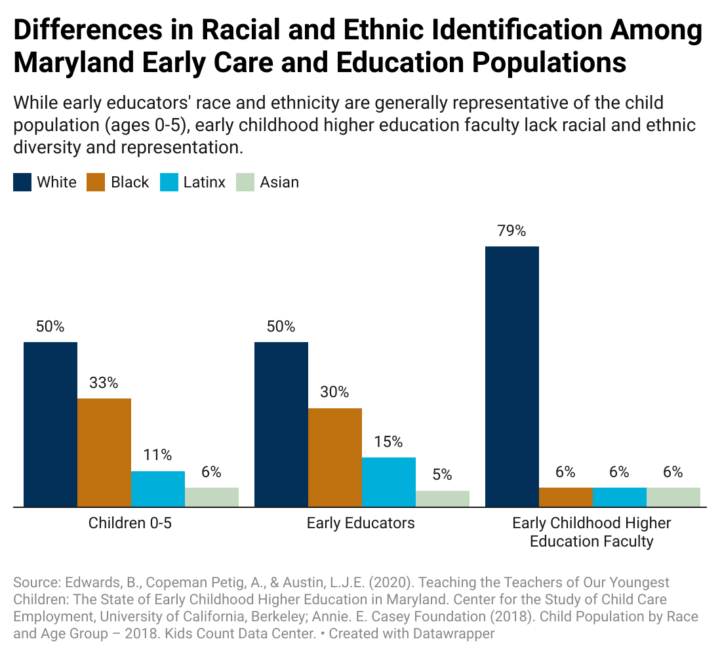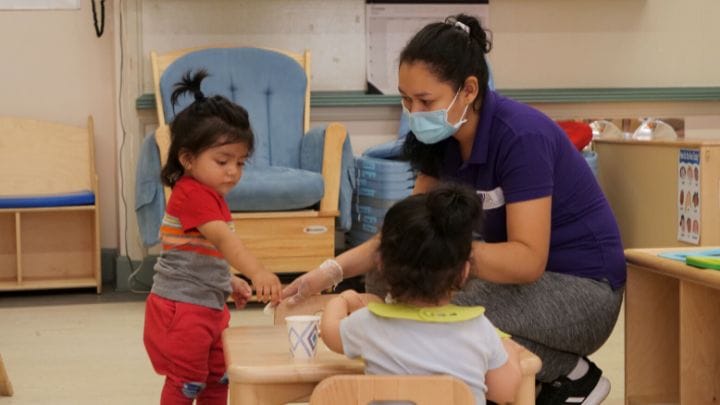Teaching the Teachers of Our Youngest Children: The State of Early Childhood Higher Education in Maryland is CSCCE’s most recent Higher Education Inventory study. This report looks at how the state’s early childhood education programs are structured and how institutions of higher education adapt to emerging knowledge about children’s learning and development in designing and implementing programs to prepare early educators.
More than 61 percent of all community college and university programs responded.1Of the 29 institutions of higher education offering early childhood degree programs in Maryland, 69 percent of institutions participated in the Inventory, including 75 percent of community colleges (n=12) and 62 percent of the public and private universities (n=8).
One of the key opportunities identified in the report is how Maryland’s early childhood education degree programs can better prepare graduates to serve an increasingly multilingual, multiracial population — a challenge that CSCCE has documented in numerous other state inventories and in a multistate report.
In Maryland, one-half of early educators identify as women of color, and nearly one-third (28 percent) of children ages 0-5 are dual language learners (DLLs) who speak a language other than (or in addition to) English at home.2Migration Policy Institute (2015). Maryland: Quick Stats on Young Children and Workers Providing Early Childhood Education and Care (ECEC). Migration Policy Institute. Retrieved from https://www.migrationpolicy.org/sites/default/files/publications/ECEC-Workforce-Maryland-FactSheet.pdf. Yet, 79 percent of faculty members preparing early educators identify as White and monolingual.

In addition, faculty report not feeling prepared to train early educators in particular areas or on certain topics, including best practices for working with children who are dual language learners or supporting the cognitive and social development of children with disabilities or developmental delays.
Based on findings from the Maryland Inventory, some of the most pressing current challenges are:
- Lack of Faculty Diversity. Faculty members do not reflect the field of early care and education. In Maryland, as well as many other states, a primarily monolingual, White faculty body is teaching a multilingual, multicultural, and multiethnic population of early educators. Studies have noted that a racially and ethnically diverse faculty is more likely to address issues of diversity in course curriculum.3Lim, C., Maxwell, K.L., Able-Boone, H., & Zimmer, C.R. (2009). Cultural and linguistic diversity in early childhood teacher preparation: The impact of contextual characteristics on coursework and practica. Early Childhood Research Quarterly, 24(1), 64-76. There’s a strong need to support children by first supporting and preparing the pipeline of diverse teaching staff.
- Limited Teacher Preparation. A majority (83 percent) of programs in Maryland reported that they do not require any practicum or student teaching experience with dual language learners. Additionally, one-fifth of degree programs do not offer any content on strategies for working with children who are dual language learners. This lack of preparation is reflective of faculty members’ own insecurity about instructing on the subject.
- Professional Development Scarcity. Faculty members expressed interest in professional development specific to DLLs, yet few had participated in such training.
How might states like Maryland better prepare faculty to meet the needs of their students and the children they teach? Currently, community colleges in Maryland offer non-credit-bearing courses and continuing education units to support adult English language learners’ English proficiency and success mastering college-level coursework. In Utah, universities partnered with the Department of Education to create specific credentials for teachers working in dual language programs.4U.S. Department of Education, Office of English Language Acquisition (2015). Dual Language Education Programs: Current State Policies and Practices. Washington, D.C. Retrieved from https://www.air.org/sites/default/files/downloads/report/Dual-Language-Education-Programs-Current-State-Policies-April-2015.pdf. Progress is being made, but more can be done.
State leaders and institutions of higher education can take steps to develop and strengthen early childhood degree programs, including the following:
- Diversify Faculty. Respondents in the Maryland Inventory indicated the importance of increasing the racial and ethnic diversity of their institutions’ faculty body (43 percent). Increased faculty diversity offers many benefits; for example, faculty from multicultural backgrounds can encourage degree completion and provide more support to students whose primary language is not English. Likewise, earning degrees can enable career advancement for early educators of color and open up doors for them to become higher education faculty themselves.
- Strengthen program content to serve DLLs. With limited required early childhood coursework, it is imperative that child development content address well-established best practices of how to support dual language learners. These include bringing in books that support a child’s home language or having the child read in both languages. Teachers do not have to speak multiple languages themselves in order to support children; however, they do need instruction on best practices for supporting DLLs in their classrooms. Additional options include adding DLL curriculum to coursework required for degree completion and offering opportunities for student teaching and/or practica with dual language learners.
- Increase faculty members’ professional development opportunities related to dual language learners. Colleges and universities have an opportunity to increase DLL professional development courses that would benefit all departments, not just their early childhood programs. Professional development for monolingual faculty members enables them to include and then teach DLL best practices. This knowledge can then help their students engage with children and families from diverse cultural backgrounds.
Maryland, like many other states, is not yet prepared to effectively meet the needs of an increasingly diverse population of children and early educators. A new influx of federal investment in the early childhood education system provides a timely opportunity to strengthen its approach as well as all higher education systems throughout the nation.

